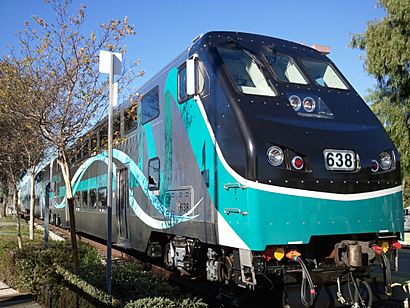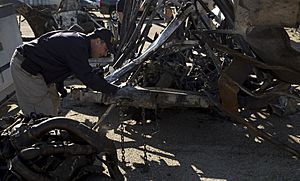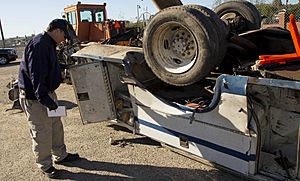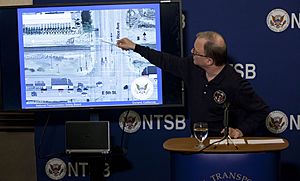2015 Oxnard train derailment facts for kids
Quick facts for kids 2015 Oxnard train derailment |
|
|---|---|

A Metrolink train similar to the one involved in the accident.
|
|
| Details | |
| Date | February 24, 2015 5:44 a.m. local time (13:44 UTC) |
| Location | Oxnard, California |
| Coordinates | 34°11′50″N 119°08′32″W / 34.19712°N 119.14227°W |
| Country | United States |
| Line | Ventura County Line |
| Operator | Metrolink |
| Incident type | Road crossing collision |
| Cause | Truck driver mistakenly turning onto railroad tracks |
| Statistics | |
| Trains | 1 |
| Vehicles | 2 |
| Passengers | 51 |
| Crew | 3 |
| Deaths | 1 |
| Injured | 33 |
The 2015 Oxnard train derailment was a serious accident that happened on February 24, 2015. A Metrolink passenger train crashed into a truck in Oxnard, California, United States. The truck driver had accidentally driven onto the train tracks and got stuck.
After hitting the truck, the train went off its tracks, which is called a derailment. Sadly, the train engineer died from his injuries a week later. Also, 32 passengers and crew members were hurt. The truck driver got out of his vehicle and ran away before the crash. He had only minor injuries that were not from the crash itself.
Contents
About the Accident Area
The accident happened on the Coast Line tracks. These tracks are owned by the Union Pacific Railroad (UP). This part of the railroad runs next to East Fifth Street (also known as California State Route 34).
Both Metrolink and Amtrak passenger trains use this line. UP freight trains also use it. About eight passenger trains and 24 freight trains travel on this line daily.
At the Rice Avenue crossing, where the crash happened, vehicles had gotten stuck on the tracks before. Emergency teams had pulled cars off the tracks about 18 times. There were plans to build a bridge for Rice Avenue to go over the tracks. This project had been planned for nearly 20 years. However, Ventura County did not have enough money for the $35 million project.
What Happened During the Crash
On February 24, 2015, early in the morning, Metrolink train #102 was traveling. It was going from Ventura County, California, to Los Angeles. At 5:44 a.m. local time, the train reached the South Rice Avenue grade crossing in Oxnard, California.
The train then hit a 2005 Ford F-450 pick-up truck. The truck was pulling a utility trailer.
The truck driver, Jose Alejandro Sanchez-Ramirez, was 54 years old. He did not know the area well and was very tired. He meant to turn right onto East Fifth Street. Instead, he accidentally turned onto the train tracks. His truck got stuck about 80 feet from the crossing.
The driver tried to push the truck off the tracks. He also said he tried to call 911 but was too panicked. Before the train arrived, he got out of the truck. He left the headlights and hazard lights on. The driver's door was also open.
GPS data from his phone showed that about 12 minutes passed. This was the time between the truck getting stuck and the train hitting it.
The train had several cars. It was led by a Hyundai Rotem cab/coach car. This car lets the engineer control the train from the front. Then came a Bombardier BiLevel coach car and two more Hyundai Rotem coach cars. A EMD F59PH diesel-electric locomotive was at the back.
There were three crew members on the train. These were an engineer, a student engineer, and a conductor. There were also 51 passengers. The train was going from East Ventura to Los Angeles. It was speeding up after leaving the Oxnard station, which was 2 miles away.
Trains can go up to 79 mph on this part of the track. Before the accident, the train was going 64 mph. The emergency brakes were put on. The train slowed to 56 mph when it hit the truck.
After hitting the truck and trailer, the train kept going through the crossing. All four passenger cars then went off the tracks. Three of them rolled over onto their sides. The locomotive at the back did not derail.
The truck was pushed along the track. It stopped about 130 feet east of the crossing. The trailer broke off the truck. It stopped at the crossing and caught fire after the crash.
Pieces from the crash also caused minor damage to a 1998 Toyota Camry. This car was stopped at the crossing, facing north. The driver of the Toyota was not hurt.
As a result of the crash, the train engineer died. Also, 32 passengers and crew members were injured. 12 passengers and one crew member had serious injuries. They were treated at several hospitals.
The truck driver, Jose Alejandro Sanchez-Ramirez, left the scene. He was later found about a mile away and taken into custody. He had minor injuries not related to the crash.
Investigation Findings
The National Transportation Safety Board (NTSB) started an investigation. A special team was sent to the accident site. The train had a camera facing forward in the cab/coach car. This camera recorded the crash.
The NTSB found that the main reason for the crash was the truck driver. He mistakenly turned onto the railroad tracks. This happened because he was very tired and did not know the area.
The NTSB investigation showed that the truck driver, Sanchez-Ramirez, had been working for nearly 24 hours. He had started his trip to Oxnard 16.75 hours earlier. This was much longer than the rules for commercial drivers allow.
The truck driver worked for The Growers Company. But he was driving a vehicle owned by Harvest Management. These two companies have the same owners and run a farm.
The cab/coach car and two of the three coach cars had a special safety system. It is called a crash energy management (CEM) system. This system is designed to absorb energy during a crash. These cars were bought after other serious Metrolink crashes in 2005 and 2008.
The NTSB found that these CEM parts, sometimes called "crumple zones", did not activate in this crash. The investigation also found that parts of the train's front (called a "pilot assembly" or "snowplow") broke off. However, this part did not cause the train to derail.
The inside of the train cars stayed mostly intact. The main reason people were hurt was because the cars rolled over. Passengers and crew then hit hard surfaces inside the train.
After the Accident
Right after the derailment, train service stopped at the accident site. Metrolink passengers had to take buses between stations. Amtrak Pacific Surfliner service was also canceled. Roads around the crash site were closed.
Train service on the line started again by Wednesday afternoon. The first passenger train passed through the crash site around 5:40 p.m.
The train engineer, Glenn Steele, was 62 years old. He was badly hurt and died one week later. Steele worked for Amtrak, which provides train crews to Metrolink. He was the most experienced engineer with Metrolink. He had worked for Metrolink for half of his 42-year career with Amtrak. Steele passed away on March 3.
The truck driver, Jose Alejandro Sanchez-Ramirez, left the scene. He was later taken into custody about a mile away. His lawyer said he was trying to get help in a remote area. He only spoke Spanish, which made it hard to communicate. When he found police, he gave them his phone. His son was on the phone and could explain what happened.
He was later charged with a misdemeanor related to the accident. In April 2019, he pleaded guilty. He was sentenced to spend 30 days in jail.
In March 2015, two people who were hurt in the crash sued the truck driver and his employer.
Metrolink announced in September 2015 that they would limit the use of the cab cars for at least a year. They wanted to review their safety features. They borrowed locomotives from BNSF Railway to add a second locomotive to each train. This second locomotive was placed in front of the cab car.
Metrolink found that the front parts (pilot assemblies) on the Hyundai–Rotem cab cars were not securely attached. In July 2016, Metrolink approved a $1.5 million plan to fix these parts. Once the repairs were done, the cars went back into service. The borrowed BNSF locomotives were then returned.
|





